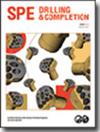Classification of Drilled Lithology in Real-Time Using Deep Learning with Online Calibration
IF 1.2
4区 工程技术
Q3 ENGINEERING, PETROLEUM
引用次数: 1
Abstract
Decision making to optimize the drilling operation is based on a variety of factors, among them real-time interpretation of drilled lithology. Because logging while drilling (LWD) tools are placed some meters above the bit, mechanical drilling parameters are the earliest indicators, although they are difficult to interpret accurately. This paper presents a novel deep learning methodology using mechanical drilling parameters for lithology classification. A cascade of deep neural networks (DNNs) are trained on historical data from wells on a field operated by Equinor. Rather than an end-to-end approach, the drilling parameters are used to estimate LWD sensor readings in an intermediate step using the first DNNs. This allows continuous updates of the models during operation using delayed LWD data. The second DNN takes the virtual LWD estimates as input to predict currently drilled lithology, similar to manual expert interpretation of logs. This configuration takes into account case-dependent [mud, bottomhole assembly (BHA), wellbore geometry] and time-varying (bit wear, wellbore friction) relationships between drilling parameters and LWD readings while assuming a constant rule when using LWD data to classify lithology. Upon completion of training and validation, the system is tested on a separate, unseen wellbore, for which results are presented. Visualizations for true lithology alongside the estimates are given, along with confusion matrices and model accuracy. The system achieves high accuracy on the test set and presents low confusion between classes, meaning that it distinguishes well between the lithologies present in the wellbore. It can be seen that the borders between successive layers of lithology are detected rapidly, which is crucial seen from an optimization standpoint, so the driller may immediately adjust accordingly. It shows promise as an advisory system, capable of accurately classifying currently drilled lithology by continuously adapting to changing downhole conditions. Although we cannot expect perfect estimates of lithology purely based on drilling parameters, we can obtain a preliminary map of the subsurface this way. This novel configuration gives a real-time interpretation of the currently drilled lithology. Thus, the drilling operation can be improved through early information and prompt drilling parameter adjustments to accommodate the current drilling environment.利用在线校准的深度学习实时分类钻孔岩性
优化钻井作业的决策基于多种因素,其中包括对钻井岩性的实时解释。由于随钻测井(LWD)工具放置在钻头上方几米处,机械钻井参数是最早的指标,尽管它们很难准确解释。本文提出了一种新的利用机械钻井参数进行岩性分类的深度学习方法。一系列深度神经网络(DNN)是根据Equinor运营的油田上油井的历史数据进行训练的。钻井参数不是端到端的方法,而是在使用第一DNN的中间步骤中用于估计随钻测井传感器读数。这允许在操作期间使用延迟的随钻测井数据连续更新模型。第二个DNN将虚拟随钻测井估计值作为输入,以预测当前钻探的岩性,类似于测井的手动专家解释。该配置考虑了钻井参数和随钻测井读数之间的随情况变化的[泥浆、井底钻具组合(BHA)、井筒几何形状]和时变关系(钻头磨损、井筒摩擦),同时在使用随钻测井数据对岩性进行分类时假设了恒定规则。完成培训和验证后,在一个单独的、看不见的井筒上对系统进行测试,并给出结果。给出了真实岩性的可视化和估计值,以及混淆矩阵和模型精度。该系统在测试集上实现了高精度,并且类别之间的混淆程度较低,这意味着它很好地区分了井筒中存在的岩性。可以看出,连续岩性层之间的边界被快速检测到,这从优化的角度来看是至关重要的,因此司钻可以立即进行相应的调整。它显示出作为一个咨询系统的前景,能够通过不断适应不断变化的井下条件来准确地分类当前钻探的岩性。尽管我们不能指望纯粹根据钻探参数来完美地估计岩性,但我们可以通过这种方式获得地下的初步地图。这种新颖的配置可以实时解释当前钻探的岩性。因此,可以通过早期信息和及时调整钻井参数来改善钻井操作,以适应当前的钻井环境。
本文章由计算机程序翻译,如有差异,请以英文原文为准。
求助全文
约1分钟内获得全文
求助全文
来源期刊

SPE Drilling & Completion
工程技术-工程:石油
CiteScore
4.20
自引率
7.10%
发文量
29
审稿时长
6-12 weeks
期刊介绍:
Covers horizontal and directional drilling, drilling fluids, bit technology, sand control, perforating, cementing, well control, completions and drilling operations.
 求助内容:
求助内容: 应助结果提醒方式:
应助结果提醒方式:


